The question soon facing the City Council—and in particular, local member Julie Won—is how much affordable housing is enough to replace the Queens industrial scene with a complex three times bigger than One45, another Harlem development proposal recently squashed over affordability concerns.
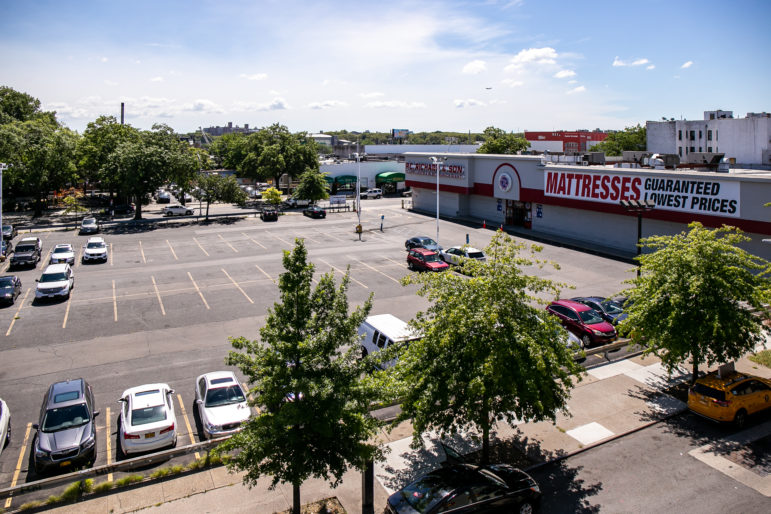
Adi Talwar
Looking Southeast from 38th Street in Astoria, part of the area that would be developed under the Innovation QNS plan.Beatriz Melo knows about change. She’s actually kind of an expert.
Melo, 35, runs a small business helping people organize their possessions and decide what is important to them as they prepare to move or downsize their homes. The job has taught her a lot about housing costs and what makes people leave where they live, she said.
Now she’s bracing for the potential effects of a major transition across the street from the Astoria apartment she shares with her husband and three kids, down the block from her mother and in-laws.
A development team comprised of the companies Silverstein Properties, BedRock Real Estate Partners and Kaufman Astoria Studios is seeking City Council approval for a residential rezoning on an industrial swath of the neighborhood bound by 37th Street to the west, Northern Boulevard to the east, 35th Avenue to the north and 36th Avenue to the south.
The developers already own much of the land—Kaufman Astoria’s headquarters are located at the edge of the proposed rezoning area—and hope to erect at least a dozen towers containing offices, retail space and 2,845 apartments, including about 700 units with rents capped for low- and middle-income earners.
“For whoever’s coming, it’s great,” Melo said. “For the small businesses and people living here, it’s sad.”
She said she and her family members are worried about the impact of a major residential rezoning, especially if their landlord decides to hike rents in their non-regulated units to keep pace with higher prices in new luxury towers. At the same time, she said, she has seen benefits from new development in Western Queens, like the area around Queens Plaza where she attended high school. “That was change in a good way,” she said of the former manufacturing district now stuffed with shimmering high-rises.
But the future of the plan to create what amounts to a brand new neighborhood in southeast Astoria is far from certain. The question soon facing the City Council—and in particular, local member Julie Won—is how much affordable housing is enough to replace the active industrial scene there. Won’s stance is crucial because the full Council traditionally defers to the member who represents the area subject to a rezoning. She has not yet made a public commitment, though she has discussed the problems she sees with the proposal, especially when it comes to affordable housing.
The project, known as Innovation QNS, has encountered opposition from the community board, progressive elected officials and even development-friendly Borough President Donovan Richards as it winds its way through the city’s land use process. They say the proposal fails to include a sufficient number of units for low-income New Yorkers who face a severe apartment shortage.
Less than 1 percent of apartments priced below $1,500 per month are vacant, according to the city’s most recent housing survey, and homelessness and evictions are both on the rise. The New York City Metropolitan Area needs about 772,000 apartments priced for very low-income residents to meet the need, according to a report by the New York Housing Conference, a policy group.
And while much of Astoria has undergone gentrification and seen median incomes and rents rise above the city average, the blocks immediately surrounding the rezoning area are home to a number of working class immigrants and other relatively low-income residents, said Community Board 1 Housing Chair Evie Hantzopolous. About 17 percent of residents of Community District 1 fall below the city’s poverty threshold, roughly on par with the rest of the borough.
“Are we going to be a diverse city?” Hantzopolous said. “Are we going to be welcoming to the kind of communities we’ve been able to welcome in Astoria?”
Doreen Mohammed, another Community Board 1 member, said she would only a support a housing complex where rents on every unit are capped for low- and middle-income tenants—an extremely unlikely prospect. “I don’t see a place where they would give in on deeply affordable housing,” she said during a walking tour of the area.
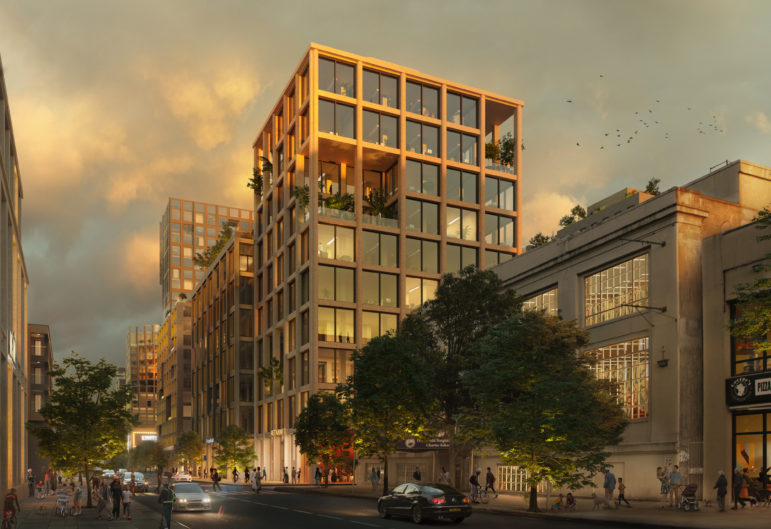
Courtesy of the developers
A rendering of the “Innovation QNS” proposal, which would erect at least a dozen towers containing offices, retail space and 2,845 apartments along a five-block stretch of Astoria.Project supporters, including officials working behind the scenes in the City Council and the Department of City Planning (DCP), counter that the plan is essential for creating more apartments for people of various income levels to meet the city’s overall need. New York City’s residential development has failed to keep pace with population growth over the past two decades, with just 0.19 units added to the city’s housing stock for every new job created between 2010 and 2018, according to the Citizens Budget Commission. Median rents are increasing across the economic spectrum and new housing supply could eventually relieve demand pressures.
During an interview with City Limits, DCP Director Dan Garodnick, who also chairs the City Planning Commission (CPC) said proposals like Innovation QNS may not be perfect but have clear citywide benefits “worthy of serious consideration by the Council.” The CPC will vote on the project by early October.
“These are issues that affect all New Yorkers,” Garodnick said. “We need to create more affordable housing, more housing at all levels and create good jobs.”
Earlier this month, Won issued a list of general demands for developers to follow if they wanted her support for a rezoning in the district, which covers southern Astoria, Long Island City, Sunnyside and Woodside.
Her rubric left room for flexibility, but she told City Limits that she was dismayed by the developers’ limited local outreach and what she said were too few units priced for households earning less than $25,000 a year. She also said she wants the Innovation QNS developers to present a revised plan to the community board and suggested they would not be able to meet her criteria for affordability and community engagement at this point in the process.
“I don’t know if it’s too late,” she said Aug. 1.
The developers declined to comment for this story. But earlier this month, Kaufman Astoria Studios Vice President Tracy Capune said she and the development team will continue to work with Won and community members to strike an agreement. They remain “proud of the plan and the important role we believe this $2 billion investment will play in addressing New York’s economic and housing crises,” Capune said.
Another One45?
A plan to upzone a chunk of West 145th Street in Harlem died earlier this year under similar circumstances. The developer behind the proposal, known as One45, decided to pull the application from review rather than meet the demands of local Councilmember Kristin Richardson Jordan, who issued a strict affordability rubric to earn her support.
Innovation QNS is roughly triple the size of One45, raising the stakes.
A few days after Won issued her guidelines, Richards, the borough president, weighed in with his advisory recommendation, a required part of the city land use review process, and drew a clearer line in the sand.
Richards said he opposed the project unless at least 50 percent of the apartments capped rents for middle- and low-income residents. He said a number of those units must be priced for people earning no more than 30 percent of Area Median Income (AMI), or about $36,000 for a family of three, the Queens Eagle first reported. A racial impact study for the rezoning plan showed that the vast majority of apartments would be priced between $2,430 and about $5,100.
“The Astoria community has made it clear that more and deeper affordability is essential to stabilizing the neighborhood,” Richards said.
Won quickly embraced the recommendation, which caught others involved in project negotiations off guard. They had expected Richards to urge developers to cap rents on 30 to 40 percent of units, according to two people familiar with negotiations. One of them, who asked to remain anonymous to discuss ongoing talks, questioned whether Richards was deliberately trying to kill the project, since the developers are unlikely to agree to his ask and Won is unlikely to back down now from the 50 percent affordability threshold.
“His actions are incredibly frustrating and gives very little room for the communities, the councilwoman, speaker, and mayor to deliver a project that will be welcomed by the residents,” the person said.
Richards wrote an op-ed for the Queens Eagle explaining that his decision was based on what he considered too few income-restricted units in exchange for city permission to overhaul a large chunk of land. He responded to criticism in a statement from his spokesperson Chris Barca.
“The Borough President cares infinitely more about delivering the most beneficial land use deals for Queens families and the communities they call home than he does about being loved in the industry,” Barca said.
On Tuesday, however, Richards met once again with the development group. Barca said they “remain engaged in discussions on expanding affordability” for the proposed project.
The developers went silent after the latest meeting with Richards and would not discuss the negotiations or concessions they might make to increase affordability at the project.
City land use rules known as Mandatory Inclusionary Housing (MIH) already force owners to cap rents on a percentage of new units in rezoned areas, but the baseline program faces consistent criticism for not providing enough deeply affordable housing. The Innovation QNS team has chosen one of two MIH options mandating that they reserve 25 percent of the units for people earning an average of 60 percent of AMI—about $56,000 for an individual and $72,000 for a family of three. About 300 of the income-restricted units would be priced below $1,000 a month, they said.
“We are living in an unprecedented housing crisis in our city,” their land use attorney Jesse Masyr told Community Board 1 ahead of the June vote. “We need all types of housing if we’re going to flourish.”
Rezoning fights are typically colored by performative horse-trading with certain concessions baked in from the start. The developer puts forth a proposal that the community opposes. The local councilmember, responding to the community, pushes for more affordable units, smaller building heights, extra greenspace or other community benefits. The developer, planning for that sort of back and forth, then concedes to some of the demands—often their plan all along—and the councilmember can claim victory.
Won told City Limits she does not want to participate in that kind of “dog and pony show.”
Still, there are political implications. Won is up for reelection next year after defeating 16 other candidates in 2021. Her rezoning decision will weigh on the minds of at least some voters.
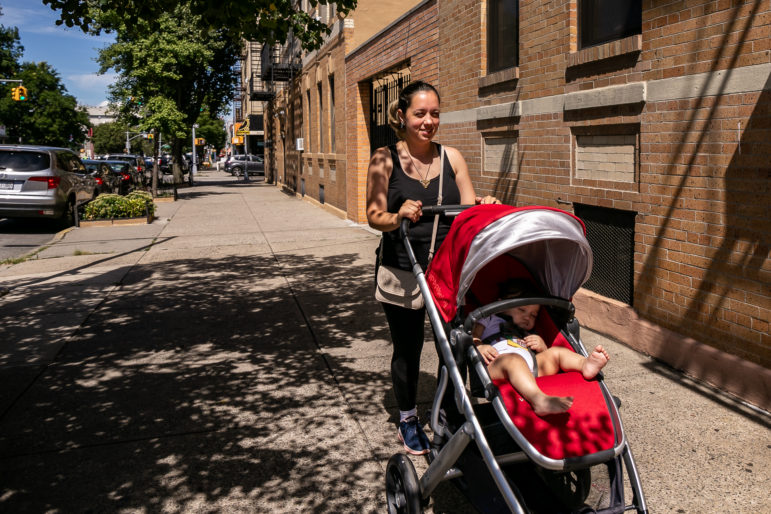
Adi Talwar
“For whoever’s coming, it’s great. For the small businesses and people living here, it’s sad,” Astoria resident Beatriz Melo said of the potential sweeping changes the rezoning would bring to the neighborhood.Business as Usual
While the politics of housing development play out, life goes on in and around the proposed rezoning area.
On a sunny Tuesday morning, a crew of electricians, welders and mechanics transformed used FedEx trucks into food carts outside a warehouse on 41st Street. Down the block, carpenters turned out custom furniture and home decor that they will install across the Northeast. And on the corner of Steinway Street and 35th Avenue, toddlers from a local daycare scrambled through a renovated playground.
Earl Belle, a manager at the heating and cooling installation company on 41st Street, said he has watched as developers purchased buildings and left them empty in preparation for the rezoning. “They bought up everything so they can put up high rises,” he said.
“I’d rather the city stay in the city,” he added, referring to Manhattan.
Queens has seen a population boom, however, growing by 7.8 percent between 2010 and 2020 censuses. And other parts of the industrial rezoning area are largely dormant, like a used car lot on 41st Street.
Belle said the business would likely find another warehouse in Queens if and when it loses the lease at its current spot.
“Business-wise it sucks,” Belle said. “We’ve got to figure out what we’ll do.”
Over on 35th Avenue, Mike Koljenovic is looking to relocate his company, which is on a monthly lease, to Florida whether or not the rezoning is approved. His Napoleon Contracting Corp. already moved from a warehouse on 33rd Street five years ago after the owner sold the property to a developer, who then built a six-story residential building. The move cost $100,000 to complete, he said.
The looming rezoning was the final nudge. “For me it’s becoming harder and harder to do business,” he said.
Across the street, Melo, the home organizing specialist, pushed her 7-month-old son in a stroller and said her uncertainty mirrored the fate of the project.
Her mother-in-law was set to move to Florida when she learned of the nearby rezoning plan, Melo said, but eventually decided to stay put to see how the potential new developments might affect her.
“It’s all going to change slowly,” she said. “I’m worried, but at the same time, I’m waiting for more information.”


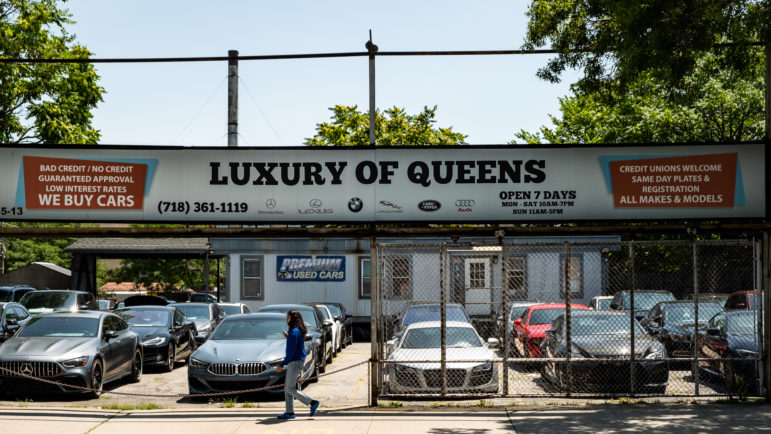
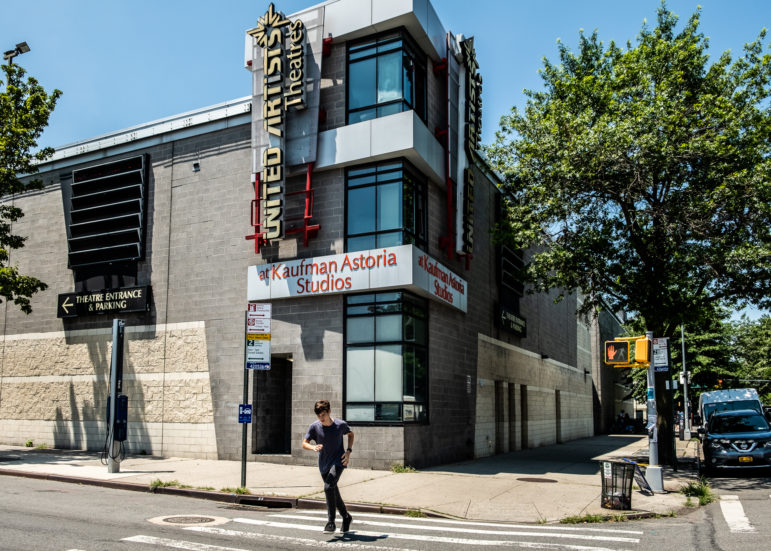
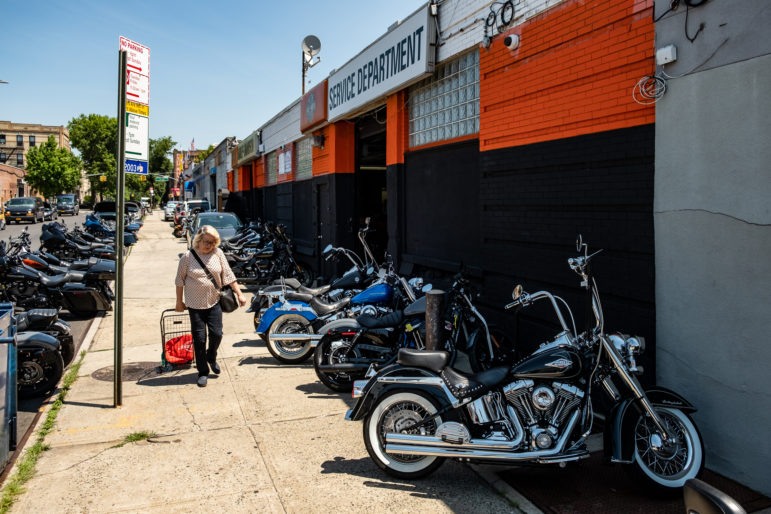







7 thoughts on “‘Innovation QNS’ Plan to Upzone Industrial Astoria on Life Support”
The fact is that Industrial NYC has been dwindling over the last 60 years. Those industrial/manufacturing jobs first went down south, then to Asia. So it does make sense to re-zone from industrial to residential in many cases. But there is still a need for at least some industrial zoned land for warehouses, etc.
There’s plenty of land zoned in NYC and in the metropolitan area for industrial purposes. Much of the single story warehousing for example could become multistory if needed too.
This project needs to die. Even if they deigned to offer 50% “affordable” units (a term which is itself problematic and easily manipulated by conniving and well-connected developers) it would still devastate the area, and the effects would ripple out to the rest of the borough. There is no way this will ever be palatable to the many people in this community who are barely making ends meet as it is, in addition to being an absurdly outsized strain on resources that have been struggling for decades. Our subways and basements are flooding, electrical grids are failing, streets are backed up with trash and traffic, and somehow we’re expected to roll over for any group of corporate weasels waiving the word “jobs” in our face? Jobs that have no certainty of even paying living wages? The few benefits they tout, like the park land that partially exists already and the rest of which would be privately owned and walled in by the luxury condo buildings, would mean nothing when thousands are evicted and an entire neighborhood is evaporated. We need to stop this in it tracks before it becomes a tumor that sentences the rest of this amazing, diverse, working-class borough to an accelerated death.
Even new luxury housing dampens gentrification.
Building nothing will only accelerate the conversion of existing housing into luxury housing.
The Innovation QNS project is designed solely for the greed of the developers. The community has been extremely clear– it is out of scale and out of financial reach for the residents of Astoria. What is clearly needed is a paradigm shift from City Planning, City Council and the Mayor’s office— requiring 75% of all units proposed for build be tied to the ACTUAL AMI of the proposed development area. It is ludicrous to use an income average of $93,400 in NYC. The figure is false, as it includes Westchester, Putnam and Rockland counties, none of which are NYC.
In Queens, the average cost per sq foot to build is roughly $500. Meaning a 600 sq ft. apartment costs $300K to build. Do the math, the amortization of the build (including a profit) breaks down to roughly $1500 monthly, which is affordable for those earning $60K annually. That STILL does not offer a solution for those earning less, which includes MANY New Yorkers. How does the oversight of our city planning justify allowing private developers to receive tax abatement, rezoning and permission to charge at will? It is time for residents to pressure their councilmen to stand up for the future of NYC. Without housing a low to middle class population, the city will no longer function, for these are the people who the ARE engine of the city.
There’s a big problem here though.
Stopping these developments doesn’t freeze the situation.
If you build a large number of luxury units, you actually dampen gentrification. If you fail to build anything you accelerate the conversion of existing housing stock to higher prices.
Julia Won doesn’t build buildings. She says things into microphones and goes to have a coffee. She doesn’t get up early enough or work late enough to be a developer. Stop rezoning, great. You geniuses need to be voted out of office.
Let me explain it really simply, Miss Won, pretend McDonald’s sells hamburgers for $2. They cost $1 to make (mostly supporting the workers, fyi, I know you love workers). Your nonsense policies want McDonald’s to give them away for free to 50% of the customers.
McDonald’s closes in your district and opens in Philadelphia, Delaware, Connecticut, Baltimore, or anywhere else there is a high demand for hamburger, which at the moment in America is EVERYWHERE.